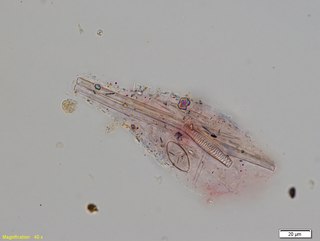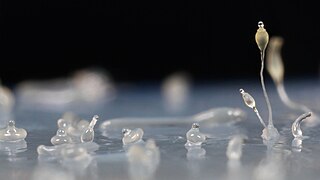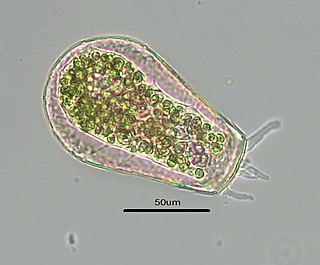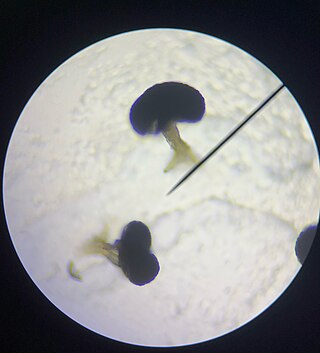
Slime mold or slime mould is an informal name given to a polyphyletic assemblage of unrelated eukaryotic organisms in the Stramenopiles, Rhizaria, Discoba, Amoebozoa and Holomycota clades. Most are microscopic; those in the Myxogastria form larger plasmodial slime molds visible to the naked eye. The slime mold life cycle includes a free-living single-celled stage and the formation of spores. Spores are often produced in macroscopic multicellular or multinucleate fruiting bodies that may be formed through aggregation or fusion; aggregation is driven by chemical signals called acrasins. Slime molds contribute to the decomposition of dead vegetation; some are parasitic.

Amoebozoa is a major taxonomic group containing about 2,400 described species of amoeboid protists, often possessing blunt, fingerlike, lobose pseudopods and tubular mitochondrial cristae. In traditional classification schemes, Amoebozoa is usually ranked as a phylum within either the kingdom Protista or the kingdom Protozoa. In the classification favored by the International Society of Protistologists, it is retained as an unranked "supergroup" within Eukaryota. Molecular genetic analysis supports Amoebozoa as a monophyletic clade. Modern studies of eukaryotic phylogenetic trees identify it as the sister group to Opisthokonta, another major clade which contains both fungi and animals as well as several other clades comprising some 300 species of unicellular eukaryotes. Amoebozoa and Opisthokonta are sometimes grouped together in a high-level taxon, variously named Unikonta, Amorphea or Opimoda.

Lobosa is a taxonomic group of amoebae in the phylum Amoebozoa. Most lobosans possess broad, bluntly rounded pseudopods, although one genus in the group, the recently discovered Sapocribrum, has slender and threadlike (filose) pseudopodia. In current classification schemes, Lobosa is a subphylum, composed mainly of amoebae that have lobose pseudopods but lack cilia or flagella.
Zoochlorella is a coloquial term for any green algae that lives symbiotically within the body of an aquatic invertebrate animal or a protozoan.

Chaos is a genus of single-celled amoeboid organisms in the family Amoebidae. The largest and most-known species, the so-called "giant amoeba", can reach lengths up to 5 mm, although most specimens fall between 1 and 3 mm.

The Amoebidae are a family of Amoebozoa, including naked amoebae that produce multiple pseudopodia of indeterminate length. These are roughly cylindrical with granular endoplasm and no subpseudopodia, as found in other members of the class Tubulinea. During locomotion one pseudopod typically becomes dominant and the others are retracted as the body flows into it. In some cases the cell moves by "walking", with relatively permanent pseudopodia serving as limbs.

Amoeba proteus is a large species of amoeba closely related to another genus of giant amoebae, Chaos. As such, the species is sometimes given the alternative scientific name Chaos diffluens.

Discosea is a class of Amoebozoa, consisting of naked amoebae with a flattened, discoid body shape. Members of the group do not produce tubular or subcylindrical pseudopodia, like amoebae of the class Tubulinea. When a discosean is in motion, a transparent layer called hyaloplasm forms at the leading edge of the cell. In some discoseans, short "subpseudopodia" may be extended from this hyaloplasm, but the granular contents of the cell do not flow into these, as in true pseudopodia. Discosean amoebae lack hard shells, but some, like Cochliopodium and Korotnevella secrete intricate organic scales which may cover the upper (dorsal) surface of the cell. No species have flagella or flagellated stages of life.

Himatismenida is an Amoebozoa order, in the class Discosea, along with Glycostylida and Dermamoebida. It contains species such as Cochliopodium gallicum.

Conosa is a grouping of Amoebozoa. It is subdivided into three groups: Archamoeba, Variosea and Mycetozoa.

Testate amoebae are a polyphyletic group of unicellular amoeboid protists, which differ from naked amoebae in the presence of a test that partially encloses the cell, with an aperture from which the pseudopodia emerge, that provides the amoeba with shelter from predators and environmental conditions.

Trichosphaerium is a genus of amoebozoan protists that present extraordinary morphological transformations, both in size and shape, during their life cycle. They can present a test that may or may not be covered in spicules. They are related to the family Microcoryciidae, which contains other amoebae with tests, within the clade Corycidia of the phylum Amoebozoa.
Sappinia pedata is a free living amoeboid organism, first described by Pierre Augustin Dangeard in 1896. It belongs to the genus Sappinia within the Thecamoebida clade of Amoebozoa and is characterized by its unique monopodial locomotion and cell surface morphology. S. pedata has been found in various habitats worldwide, mostly on herbivore dung, decaying plant matter, and soil. The species has gained attention due to its potential medical relevance and has been the subject of most recent and emerging studies in Protistology and Eukaryotic Microbiology as a whole.
AmoebaDB is a functional genomics database for the genetics of amoebozoa.

An amoeba, often called an amoeboid, is a type of cell or unicellular organism with the ability to alter its shape, primarily by extending and retracting pseudopods. Amoebae do not form a single taxonomic group; instead, they are found in every major lineage of eukaryotic organisms. Amoeboid cells occur not only among the protozoa, but also in fungi, algae, and animals.

Hyalospheniidae is a family of arcellinid testate amoebae and the sole family of the infraorder Hyalospheniformes. Commonly referred to as "hyalospheniids", these lobose amoebae are characterized by their ability to generate a shell composed of either organic matter or siliceous particles that may be recycled from euglyphid amoebae. They inhabit soil or freshwater habitats, and are abundant on Sphagnum mosses.

Cryptodifflugiidae is a family of arcellinid testate amoebae.

Amoebozoa of the free living genus Acanthamoeba and the social amoeba genus Dictyostelium are single celled eukaryotic organisms that feed on bacteria, fungi, and algae through phagocytosis, with digestion occurring in phagolysosomes. Amoebozoa are present in most terrestrial ecosystems including soil and freshwater. Amoebozoa contain a vast array of symbionts that range from transient to permanent infections, confer a range of effects from mutualistic to pathogenic, and can act as environmental reservoirs for animal pathogenic bacteria. As single celled phagocytic organisms, amoebas simulate the function and environment of immune cells like macrophages, and as such their interactions with bacteria and other microbes are of great importance in understanding functions of the human immune system, as well as understanding how microbiomes can originate in eukaryotic organisms.
Copromyxa protea is a cellular slime mold belonging to the supergroup Amoebozoa. The taxonomical history of C. protea starts as Guttulina protea and ultimately ends with becoming its own genus of protists. Its morphological features like tubular mitochondrial cristae help pinpoint its placement in its supergroup, as well as its pseudopodia. The life cycle of this cellular slime mold is outlined and expanded upon, delving into specific characteristics of each component in the stages. The specific environments where C. protea was gathered for experimental purposes is also detailed.

Protosteliopsis fimicola is an amoeba that forms a fruiting body that consists of a single spore with a non-cellular stalk. This species was thought to be closely related to the species P. mycophya, but it was found that it has a significant difference from this species because of having an irregular stalk and non-deciduous spores. Later it was found that Protosteliopsis is a part of group 6 in the genus Vannella based on 18s rRNA molecular phylogenetics.












